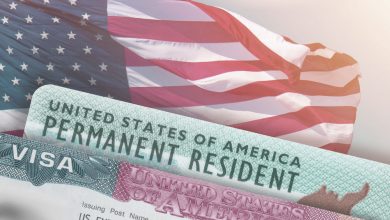What are the easiest and fastest ways to migrate to the United States?

Every year, tens of thousands of immigrants arrive in the United States. Some people come for a brief visit, while others want to remain longer.
Take a look at the information below if you’re interested in immigrating to the United States for employment or to reconnect with relatives. The numerous options may change depending on whether you desire to stay permanently or for a brief period.
The reason for your visit will also be important. Below, we’ll go through some of your options and the many visas you may apply for.
The easiest and fastest ways to migrate to the United States
Visa vs. Green Card: What’s the Difference?
The major distinction between a visa and a green card is the length of residence in the United States.
Your stay on a nonimmigrant visa isn’t indefinite. Some can be renewed for a specific period of time, while others can be renewed permanently.
A green card, on the other hand, signifies long-term residence. A green card, unlike a nonimmigrant visa, permits you to remain in the United States indefinitely and opens the way to citizenship. A green card is far more difficult to get than a visa, and there are only a certain number of green cards available each year.
The number of green cards that can be obtained is also limited by your country of origin (meaning which country you come from). As a result, some countries have far greater wait times than others.
Alternatives to Immigration
As previously stated, there are several immigration alternatives accessible.
Most visas need someone else to apply on your behalf (such as an employer or a family member in the United States). The O-1 and J-1 visas are two of them. On a few visas, you can apply for yourself (such as the EB-1A visa).
Let’s have a look at some of the possible visa choices.
Options for Temporary Visas
If you just wish to visit the United States for a short time, there are a variety of visas available. This might be for a variety of reasons, such as studying or working on a certain project.
The following are some of the visas available:
The B-1 visa is a business visiting visa that permits you to enter the United States to do business. This might be anything from attending conferences or board meetings to forming a new company or communicating with consumers.
F-1 visa
Despite the fact that the F-1 visa is solely for study, you can still work through Optional Practical Training (OPT).
Even if you need to study on an international student loan, you can use the F-1 visa. If you’ve finished your studies but want to stay in the United States, you should apply for an H-1B visa.
Entrepreneurial Options
If you’re an entrepreneur looking to start a firm in the United States, you have a few more alternatives.
The following are some of your options:
EB-1C
If you are a multinational corporate executive, you can apply for an EB-1C visa to travel to the United States and create an office for your firm.
L-1A
If your company is a startup and you need to move the founder or an executive from your present office to your new location in the United States, you can use the L-1A visa.
H-1B
The H-1B visa can be used in conjunction with an Entrepreneur-in-Residence program offered by a number of American universities.
E2
E2 visas are designated for entrepreneurs who are headquartered in a nation with whom the United States has a trade agreement. The E2 visa may be appropriate if you began your firm in your native country and there is a trade pact in existence.
TN
The TN visa is a Treaty National visa that allows you to work in one of the eligible professions as a Canadian or Mexican entrepreneur.
Alternatives for Families
If you are a family member of a United States citizen or permanent resident, they may be able to sponsor your visa to the United States.
Whether the sponsor is a citizen or a permanent resident determines which family members can be sponsored. Citizens of the United States can sponsor:
- Their partner
- Children who are married or unmarried (on the H4 visa)
- Children’s siblings (but then the sponsor must be at least 21 years old)
Green card holders are eligible to sponsor:
- Their partner
- Children who have never been married.
- A K-1 visa may be appropriate if you want to marry a U.S. citizen. On a K-1 visa, you will be able to visit the United States for 90 days, during which time you must marry. You can apply for a marriage-based green card once you’ve married.
Optional Premium Processing
We understand that you may not have the luxury of waiting months (or even years) for your visa. Your wait time is cut in half with premium processing, to roughly two weeks (15 calendar days). The USCIS guarantees this period of time. Unfortunately, premium processing is only available for specific types of employment or work-related visas.
This rapid turnaround comes at a cost. You can file an expedite request if your visa does not qualify for premium processing but you cannot afford to wait too long.
You can always submit a Writ of Mandamus if you have no other choice. However, it is not an easy procedure. The procedure is filing a lawsuit in which the court directs the USCIS to carry out its legal obligations by rendering a decision on your immigration application. A writ of Mandamus is only used as a last option in the direst of circumstances.
Conclusion
If you’re traveling for business, the L1 or B1 visas are options. The K1 or a dependant visa may be a preferable alternative if you wish to be reunited with your family or prospective spouse.
Whatever the situation may be, begin your application procedure as soon as possible. For each type of visa, there are different waiting times, and you’ll want to get in line as soon as possible. You now know how to immigrate to the United States of America!
